AMD’s Radeon HD 5850: The Other Shoe Drops
by Ryan Smith on September 30, 2009 12:00 AM EST- Posted in
- GPUs
Power, Temperature, & Noise
With Cypress pared down some for the 5850, the power/temperature/noise situation takes on a different look. The 5870 ended up being hot, noisy, and more power-hungry than any other single-GPU setup under load. Let’s see if the 5850 can avoid that.
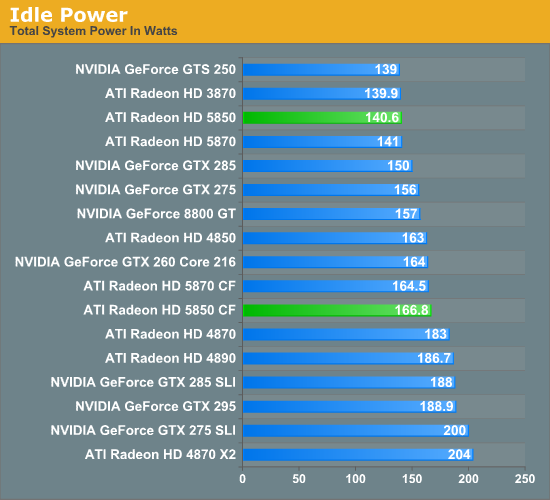
Looking at idle power, the results are the same as the 5870. This is to be expected as both are capable of reaching the same low idle power state. Crossfire results are similar, although the 5850 CF nudges itself higher than the 5870 CF on our charts; but this is within experimental variance.
As was the case with the 5870, the 5850 is among the lowest idling cards we have seen. It’s at the very bottom, only the Radeon HD 3870 and the GeForce GTS 250 can beat it, and even then just by a watt and a half.
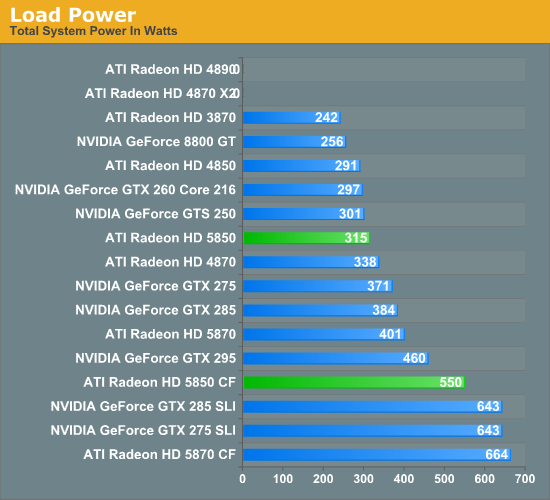
Load power on the other hand gives us a surprising difference. While the 5870 was one of the most power-hungry single-GPU cards we tested, the 5850 moves half-way down the chart. At load it uses less power than 4870 and most of the GTX series, in effect using less power than all of its closest performance competitors. In fact the difference in load power is beyond the specs; AMD’s specs call for a 37W difference, but here we have an 86W difference. Even after accounting for power supply inefficiencies, this is still a huge difference. We’re not seeing clock throttling occurring, so at this point we don’t have a complete explanation for what we’re seeing beyond the fact that we’re sure these are legitimate results.
The end result is that it’s clear that the 5850 is going to work well in systems with limited power abilities. At the same power envelope it’s significantly faster than anything else, and at the same performance level it’s significantly less power hungry than anything else.
As for Crossfire, this gap closes somewhat in that configuration. Here it’s only 114W under the 5870 CF, and just 93W under the GTX SLI cards. Even with its low power usage, the 5850 can’t erase the fact that multi-card solutions eat much more power than single-card solutions; it’s 90W over the GTX295, for example.
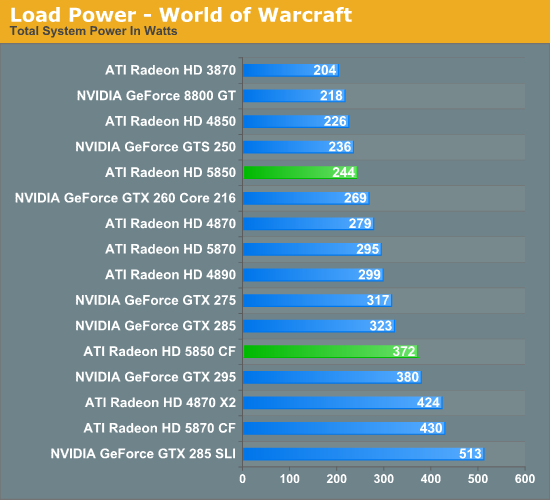
We’ll also take a look at power usage in Warcraft quickly, since it doesn’t trigger throttling in our other AMD cards. Warcraft doesn’t push these cards like OCCT does, so the overall power usage is lower, but the overall situation is virtually the same. The 5850 comes in at 55W less than the 5870, and this time bests the entire GTX lineup by at least 25W. We also see Crossfire do better here; now the 5850 CF can beat even multi-GPU cards like the 4870X2 and the GTX 295.
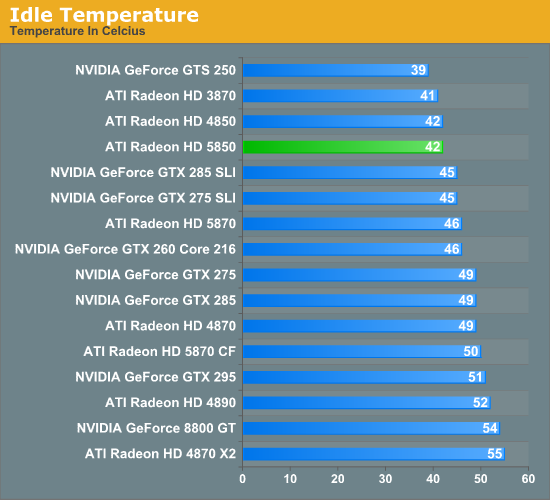
Interestingly enough, in spite of the same idle power as the 5870, the idle temps are not the same. The 5850 comes in at a chilly 42C, bringing it in line with the 4850 and the 3870. Only the GTS 250 can beat it by 3C, and in turn the 5850 beats its closest competitors, the GTX series, by at least 3C.
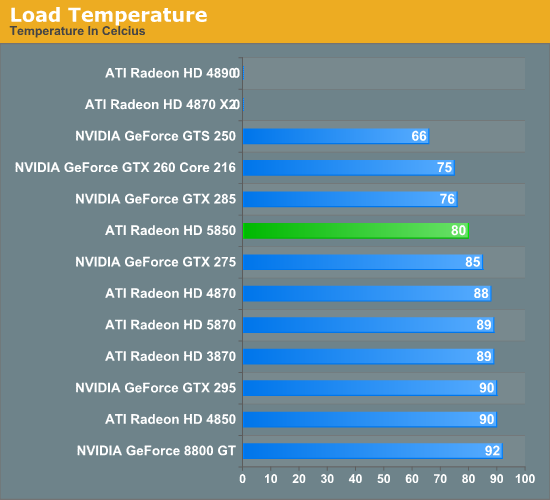
With lower power usage and a similar cooler, the 5850 is capable of keeping cooler than the 5870. While the 5870 approached 90C, the 5850 we’re testing was able to stay at 80C. This makes it the only AMD card we’ve tested that isn’t approaching 90C, which is good news for those of you with limited case ventilation. However it still loses to the GTS 250, and most of the GTX cards. We know NVIDIA is consuming more power, so clearly they have a more effective cooler in use if it’s able to cool their cards that well.
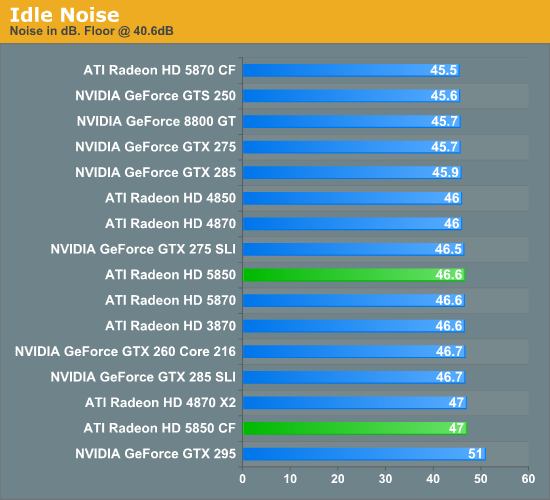
Finally we have noise. At idle virtually everything is the same, the 5850 and the 5870 come in at 46.6dB. To see a significant difference here, we would have to switch to a passively-cooled card.
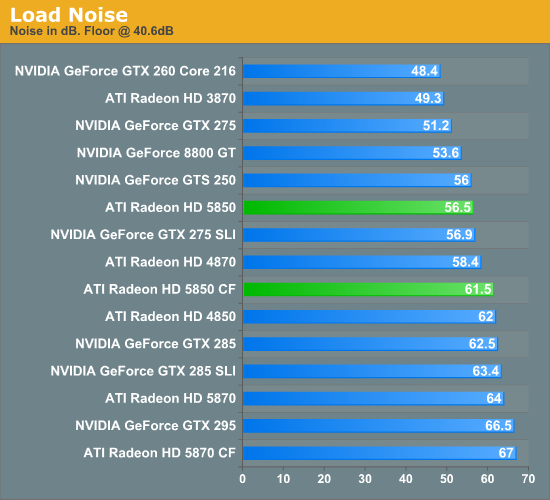
At load, the 5850 is just below the middle of the pack. Thankfully it’s not nearly as loud as the 5870, shaving off 8dB compared to its big brother and brings a Cypress-based card in to more reasonable territory. Adding a second card for Crossfire makes things louder at 61dB, but even that is still 6dB quieter than the 5870 CF.
This also shows us the tradeoffs NVIDIA made in cooling compared to AMD. The GTX 285, which was cooler running, is 6dB louder here as a result. Going by our charts the 5850 is fairly balanced in noise and temperature; it’s doesn’t need to make any trade-offs to achieve one or the other.










95 Comments
View All Comments
merin - Tuesday, October 6, 2009 - link
Thanks Pastuch :)I'm in the process of getting a new graphics card, and I'm trying to find the most silent one that doesn't nerf performance from the top cards that much. The 3 cards that I'm considering is:
This 5850 from ATI (probably Sapphire or Asus)
Sapphire HD4890 Vapor-X
MSI N275GTX Twin Frozr OC
Any advice?
Pastuch - Wednesday, October 7, 2009 - link
I was looking at the the exact same cards. Both the Twin Forzr GTX275 and the Radeon 4890 vapor-x are VERY QUIET. I would pick based on which games you play. If you have a home theater and audio passthrough is a concern I would lean towards the ATI card. Both of them come pre-overclocked and both have stellar performance. The Twin Frozr is slightly longer in length; however it's power connectors face up (Not out the back of the card like usual).Ryan Smith - Monday, October 5, 2009 - link
Yes. That's the noise of our test rig that we measure at idle when using an entirely passive video card; we can get our rigs down to about 36dB, but that requires removing all the fans other than the CPU fan. Bear in mind that a dead quiet room is 30dB and that we're measuring roughly 6" away from the card, so our methodology may differ from how other people do it.merin - Tuesday, October 6, 2009 - link
Thank you Ryan!So what do you think is the most silent? This 5850 with a reference cooler or the 4890 vapor-x? I find them very hard to compare because of different methodology...
Right now, they only thing in my case that is making noise is the fan on my old 8800GTS, and I'd like my new card to make it completely silent if possible.
Ryan Smith - Tuesday, October 6, 2009 - link
Since we haven't tested the Vapor-X, I have no way of knowing.MamiyaOtaru - Friday, October 2, 2009 - link
260 core 216 is using more power yet running cooler with a quieter fan.. would love to see a 5850 with a more efficient coolerAnnonymousCoward - Thursday, October 1, 2009 - link
DisplayPort 1.1 vs 1.2 is the difference between PCIe 1.0 vs 2.0. The bandwidth is doubled. Please start stating the version.coconutboy - Thursday, October 1, 2009 - link
I didn't read all the comments yet so perhaps this has been mentioned, but where are all the 5850 Xfire results? Hopefully the Crossfire benches weren't done exclusively at 2560x1600? From some of Ryan's text in the article, it seems there were Crossfire results that are accidently missing or got pulled. Stuff like this quote from the Battleforge page 6 text:Yet there are no Xfire results on any of the Battleforge graphs. Hopefully they'll be added later. In the meantime guru3d and HardOCP have Xfire results for those interested.
coconutboy - Thursday, October 1, 2009 - link
Had a chance to go through all the comments now, seems TheOne pointed out the same thing on page 6 of the comments and Ryan attempted to fix it. The fix still ain't showing up in my browser though.Ryan Smith - Thursday, October 1, 2009 - link
It's really fixed this time. I had two sets of graphs, one with the CF/SLI cards and one without. I put up the wrong one.